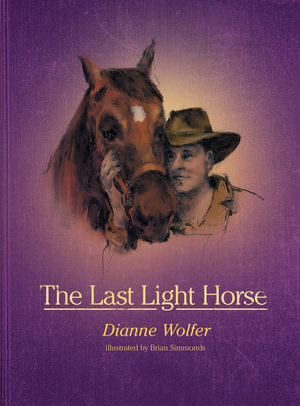The last Light Horse by Dianne Wolfer. Illus. by Brian Simmonds

The Last Light Horse is the fourth and final book in the Light series, which began with Lighthouse Girl followed by Light Horse Boy and In the Lamplight. Each story provides older children with an historical account of different aspects of World War One. Each book is a stand-alone story and this final book with its striking purple cover and gold writing, contains detailed charcoal sketches as well as archival facts and photographs and will truly complete this wonderful series.
This remarkable story is about Sandy, the only returning Australian warhorse from 136,000 sent to the battlefields of the World War One. His journey was one of hardship and danger and is told from his perspective in four compelling sections under the title of his handler at time. We first meet Sandy as a foal in the High Country of Victoria and then with Francis who trained him to carry bricks in the town of Tallangatta. Francis patriotically donates Sandy to the war effort, and he becomes the property of Major General Bridges. In October 1914, Sandy is loaded onto the Orvieto, flagship of the Australian Fleet, and is one of three horses, or Walers as they were known, belonging to Major Bridges. Conditions on the ship were hard for the horses and they were at sea for five weeks. They disembarked in Alexandria where they regained fitness before heading off to the Gallipoli Peninsula arriving on April 25.
Sadly, Major Bridges was seriously injured and passed away. Sandy then came under the care of veterinarian, Captain Leslie Whitfield, and in 1916 they were sent to France where they were a part of the Battle of the Somme. Captain Whitfield handed over the care of Sandy to Private Archibald Jordan who was suffering from the horrors of the war. Archie and Sandy formed a strong bond and Sandy who had damaged his eyes relied on Archie more and more.
Eventually Sandy and Archie were sent back to Australia in November 1918. Sandy’s journey did not end there. As the only returning war horse he was very much in the public eye. He was saddled and ridden in ANZAC Day marches for as long as his health allowed and was honoured with a replica statue placed at Albany’s Mount Clarence.
For older primary and lower secondary students this book along with the others in the series would make excellent resources for ANZAC Day and World War One topics.
Further information for teachers is available here.
Themes: First World War, Horses, Australia, Infantry, Suffering, Death, Loss, Light Horse, ANZAC Day.
Kathryn Beilby